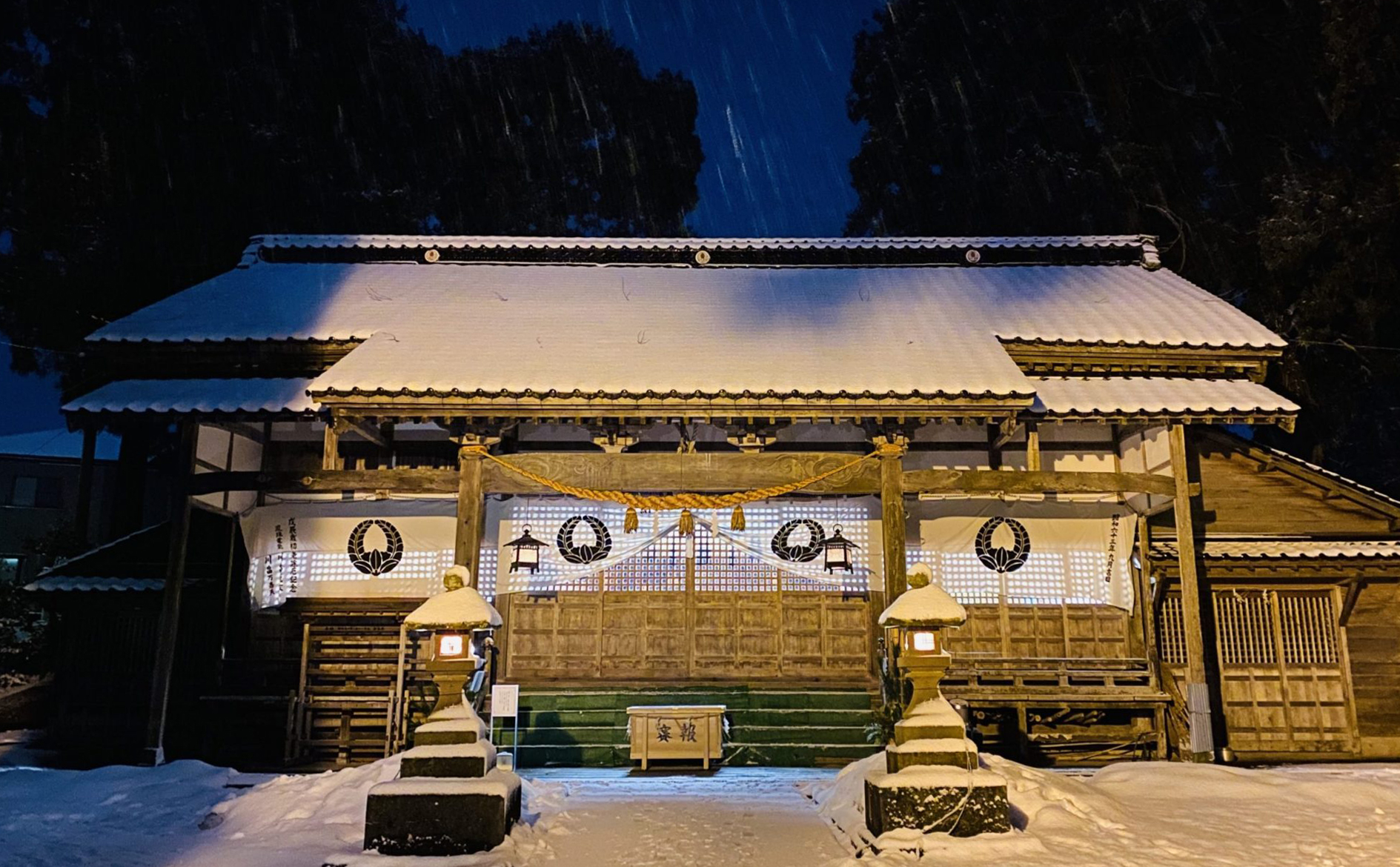With the wind of Ai, I arrived on this beach riding on a sake barrel.
According to legend, this deity is said to have arrived by drifting on a sake barrel at the mercy of the Aoi wind (Note 1). Therefore, it is said that the Aoi wind always blows during the spring festival to commemorate those days (Note 2). It is the most famous shrine in the prefecture with a legend of a deity drifting ashore. The name of this shrine is also named after the deity who “arrived on a sake barrel to this beach.”
It is said that a torii gate was built at the landing point, but it was relocated along with the land reclamation of the sea, and it is no longer in its original location. It is currently located near the Noto Fisheries Cooperative Association’s Noto Branch, still referred to as the “Otabisho,” and plays an important role during pilgrimages and rituals. The local people consider the area from the landing site to the old main shrine (current shrine office) as a sacred place and have avoided impurities such as childbirth.

Deities:
- Oyamatsumi-no-Mikoto
- Ukanomitama-no-Mikoto
- Ōgami Tennō
- Jingū Kōgō
- Sugawara-no-Michizane
- Inabeashira-no-Mikoto
History of Sakataru Shrine:
Heian Period – Establishment of the Main Shrine: The shrine’s detailed records state that “The main shrine was established over a thousand years ago, and it is said to have been founded during the reign of Emperor Ninmyō” (Note 4). The mention of “Emperor Ninmyō’s reign” refers to the early Heian period, from 833 to 850 AD, but the records are only found in this shrine’s documents, and its origin remains unknown (Note 4).
Kamakura Period – Indication of a Special Shrine Status: Records from 1261 AD mention a donation by the Kamakura period of the shrine’s land, known as “Kandagodan” (Note 5). However, there are also records from the same period that mention the shrine’s land in a list of holdings (Note 3). The reason for this special consideration remains unclear.
Edo Period – Great Fire and Relocation to Uenohata Plateau: In June 1799, a fire broke out and destroyed 194 houses in the parishioner area, including the shrine’s head priest and the Kato family (Note 22). Ironically, the shrine’s head priest at that time, Kato Yoshihiko, was away on a pilgrimage to Ise. In March 1815, the shrine was relocated to “Uenohata,” and a detailed record of this event is available (Note 6). The move was accompanied by the construction of the shrine, with the raising of the main hall on the 15th day of March, the relocation on the 16th, the evening festival on the 17th, and the main festival on the 18th. The head priest at that time was Kato Taka-hiko, the son of Yoshihiko. Although the exact location of “Sakataru Shinkurowashiki,” as it was known, cannot be confirmed, it is believed to be near the current shrine office. The shrine has been at its current location for about two hundred years. This relocation to a place away from houses may have been due to the trauma caused by the great fire. It took 16 years to rebuild the shrine.
Hereditary Shrine Family and the 12th Head Priest, Kato Yoshihiko:
Shrine Family: In 1680, there is a record of “Kato Hyuga-no-Kami” in the “Noshū Kiki Jinsyo Harai Tukasa Zukuri Chohō” as “Uotsu Village, Sakataru Daimyojin, Kato Hyuga-no-Kami, etc.” The Kato family has been a hereditary shrine family through the generations. The ancestors can be traced back to Takai, as stated in the family records (Note 7). The family records mention, “The father and the year and month of the founding are unknown, passed away in May of the second year of Tenbun (1533),” indicating that the family was established in the latter half of the Muromachi period. This period coincided with the emergence of powerful feudal lords such as Oda and Asai, as well as the rise of Buddhist forces, including the Ikko Ikki sect led by Rennyo. The “U-saku” (Note 8), which signifies the appointment to the rank of “Jugoinoge” (fifth court rank, lower grade), is preserved in the family records as proof of the priesthood’s appointment.
Kato Yoshihiko and His Mentor, Motoori Norinaga: The 12th head priest of the shrine, Kato Yoshihiko, entered the residence of the renowned scholar of national learning, Motoori Norinaga, in the “Suzuya” village in 1797 (Note 9). This decision was influenced by the guidance of North Gotōmon Masataka, a Mito scholar who visited Uotsu, which was filled with eager learners, and encouraged Yoshihiko to study. Yoshihiko’s entry into the school of the Matsumoto clan in Ise was a result of this guidance. He was 36 years old at the time, while Norinaga was 68. Yoshihiko documented his journey of entering Norinaga’s school in a travel diary titled “Chihiro no Hama Sō,” which included poetry. Yoshihiko visited Norinaga’s school in Ise three times and authored a total of 152 works, comprising 312 volumes, throughout his life (Note 11 & 12). There are various pieces of evidence that provide insight into Yoshihiko’s personal and direct relationship with Norinaga:
- “Chihiro no Hama Sō” (Note 6): In 1797, when Yoshihiko returned to Noto, Norinaga and other prominent disciples composed farewell poems for him.
- “Suzuya Ō Nanajukka Aishū” (Note 14): A collection of poems celebrating Norinaga’s seventieth birthday. A poem written by Yoshihiko is included.
- “Kojiki Handaikashū” (Note 16): In 1798, Norinaga organized a collection of poems titled “Kojiki Handaikashū” in celebration of the completion of his commentary on the Kojiki. Yoshihiko composed a poem in praise of the powerful deity mentioned in the Kojiki.
In a letter addressed to Yoshihiko by Norinaga in November 1799 (Kansei 11), Norinaga mentioned his meeting with several people from Uotsu, including Jōshōji Nukayama (a priest), Iimori Gotō (a commoner), and Shimizu Kōemon Noritoshi (a commoner). Norinaga also mentioned that his work “Sengonok
